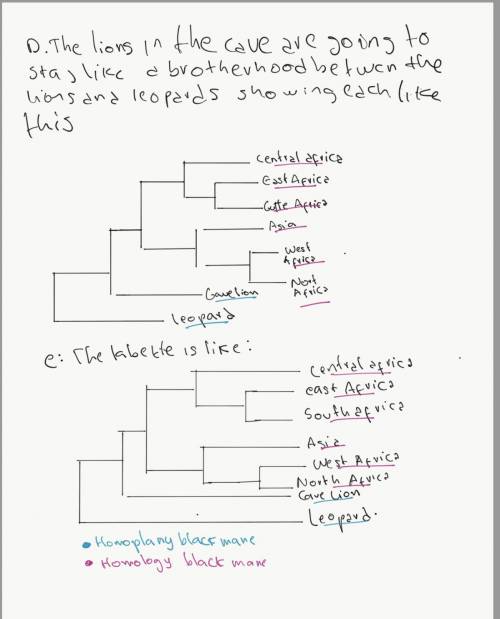
A study published earlier this year used genomic data to construct a phylogenetic tree of lions. All of the lions on the tips of the tree are extant (living).
A. This study discredits the idea that there are two distinct geographic variants of lions: one with lion populations from Central Africa, Asia, and West Africa and the second with lion populations from South Africa and East Africa. Use the tree to defend why these two groups of lions are unlikely.
B. North African lions are critically endangered and some populations have gone locally extinct. Some scientists claim we can "use the most closely related Asian Lions to restore the population." Using what is wrong with this statement, defend which lineage would be better for the purpose of restoring North African lions.
C. The authors of the study measured the amount of heterozygosity in each population of lions and found more
homozygosity (less heterozygosity) in the monophyletic group of lions in Asia, West Africa, and North Africa (compared to the monophyletic group of Central, East, and South Africa).
• Use this information to infer the size of the isolated populations when divergence occurred. Explain your
reasoning.
• Of the populations in Asia, West Africa, and North Africa, which population likely has the least heterozygosity?
Explain your reasoning.
D. The study used the now extinct Cave Lions as sister taxa to modern lions and Leopards as an outgroup to root their tree. Use SketchPad and the template provided named "SketchPadExam3OfficialTemplate. sketchpad" to add "Cave Lion" and "Leopard" to the tree.
E. South African lions and North African lions have black colored manes (compared to the others that are lighter). Use the same tree on the SketchPad template (on which you drew cave lions and leopards) to mark the origin of the black manes if this trait is homologous: Label it "Homology". Mark the origin of black manes on the tree under the hypothesis that it evolved independently: Label it "Homoplasy"
F. Using on the information you drew on the tree in part e, which hypothesis do the data support?
G. State whether each of the following statements is true or false.
A. The monophyletic group of Asian lions has undergone less evolution than the monophyletic group including West African and North African lions.
B. Asian lions have a very small mane. Reduced manes are a derived trait.

Answers: 1
Another question on Biology

Biology, 21.06.2019 16:40
Sand spinifex grass is adapted to growing on sand dunes. it is a rapidly spreading plant and the creeping runners produce new root systems. which of these best explains the benefits of these features? a. it limits water loss through the leaves. b. it provides support by anchoring the plant. c. it protects the plant from predators. d. it allows the plant to tolerate salt. reset submit
Answers: 3

Biology, 21.06.2019 20:00
Which medullary index indicates a human hair? a. 0.653 b. 0.733 c. 0.516 d. 0.256
Answers: 1

Biology, 21.06.2019 23:00
Biomass can be used to generate electricity. biomass relies heavily on agricultural crops. plants release carbon dioxide and water in combustion. plants use photosynthesis to originally generate the energy that is needed. the chemical energy of these plants all started with what energy source?
Answers: 3

Biology, 21.06.2019 23:00
Which best describes the digestive system of arthropods? a incomplete, two openings b complete, one opening c two-way, one opening d one-way, two openings
Answers: 3
You know the right answer?
A study published earlier this year used genomic data to construct a phylogenetic tree of lions. All...
Questions


Engineering, 28.01.2021 03:00

Engineering, 28.01.2021 03:00


Mathematics, 28.01.2021 03:00

Physics, 28.01.2021 03:00

Mathematics, 28.01.2021 03:00

English, 28.01.2021 03:00

Mathematics, 28.01.2021 03:00

Mathematics, 28.01.2021 03:00

Biology, 28.01.2021 03:00






Mathematics, 28.01.2021 03:00






